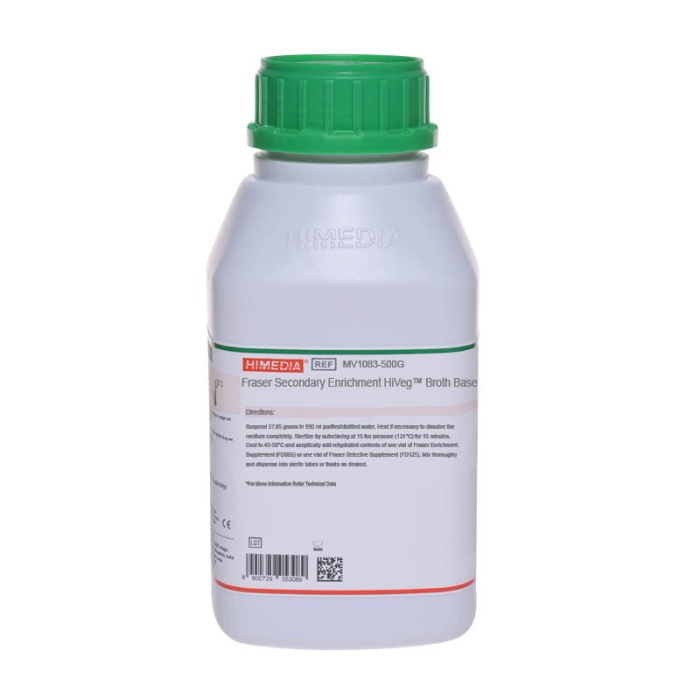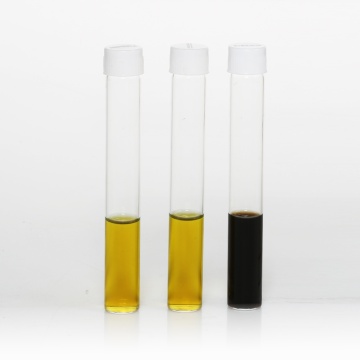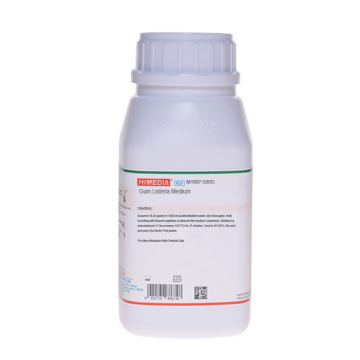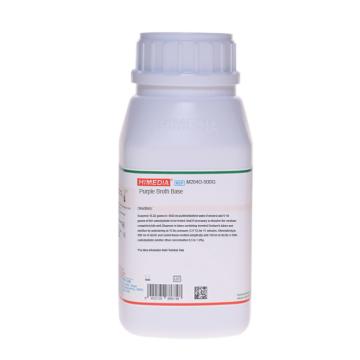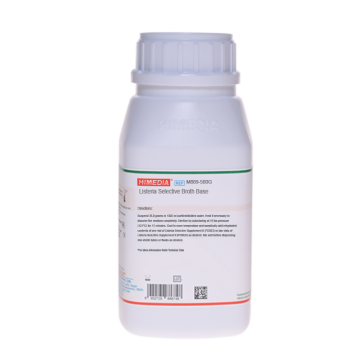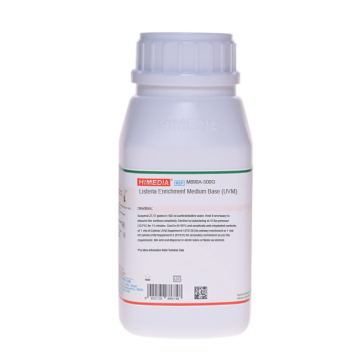 Your enquiry has been submitted
Your enquiry has been submitted
Fraser Secondary Enrichment Broth Base
Listeria#CC293D
Intended Use
Recommended for the isolation, cultivation and enrichment of Listeria monocytogenes from food and environmental specimens.
Composition
| Ingredients | Gms / Litre |
|---|---|
| Proteose peptone | 5.000 |
| Tryptone | 5.000 |
| Yeast extract | 5.000 |
| HM peptone B # | 5.000 |
| Sodium chloride | 20.000 |
| Lithium chloride | 3.000 |
| Disodium hydrogen phosphate | 12.000 |
| Potassium dihydrogen phosphate | 1.350 |
| Esculin | 1.000 |
| Ferric ammonium citrate | 0.500 |
Final pH (at 25°C): 7.2±0.2
**Formula adjusted, standardized to suit performance parameters
# Equivalent to Beef extract
Directions
Suspend 57.85 grams in 990 ml purified / distilled water. Heat if necessary to dissolve the medium completely. Sterilize by autoclaving at 15 lbs pressure (121°C) for 15 minutes. Cool to 45 - 50°C and aseptically add rehydrated contents of 1 vial of Fraser Enrichment Supplement (FD065) or one vial of Fraser Selective Supplement (FD125). Mix thoroughly and dispense as desired.
Principle And Interpretation
Fraser Secondary Enrichment Broth is a modification of United States Department of Agriculture-Food Safety Inspection Service (USDA-FSIS) UVM Secondary Enrichment Broth. It is based on the formulation of Fraser and Sperber (2) and found to be remarkably accurate in detecting Listeria species in food and environmental samples (5). Fraser Secondary Enrichment Broth is recommended by APHA (6). Fraser Secondary Enrichment Broth Base is formulated so as to provide optimum conditions for the growth of Listeria.
Proteose peptone, Tryptone, yeast extract, and HM peptone B make the media highly nutritive by providing essential nutrients including carbonaceous and nitrogenous substances. Phosphates maintain the buffering capacity of the medium.
All Listeria species exhibit ß-glucosidase activity which is evident by the blackening of the media. Listeria species hydrolyze esculin (substituted glucoside) to glucose and esculetin. The latter combines with ferric ions of ferric ammonium citrate, resulting in the formation of 6-7 dihydroxycoumarin, a black brown complex. Ferric ammonium citrate also enhances the growth of L. monocytogenes (1). The high salt tolerance (of sodium chloride) of Listeria is used as means to inhibit the growth of Enterococci. Lithium chloride is also used to inhibit Enterococci, which also possess the ability to hydrolyze esculin. Growth of accompanying bacteria is largely inhibited by the addition of Nalidixic acid and Acriflavin hydrochloride (FD).
Type of specimen
Food samples and Environmental samples
Specimen Collection and Handling
For food samples follow appropriate techniques for handling specimens as per established guidelines (6).
For environmental samples, follow appropriate techniques for sample collection and processing as per guidelines (3,4).
After use, contaminated materials must be sterilized by autoclaving before discarding.
Limitations
- Further biochemical and serological tests must be carried out for further identification.
Performance and Evaluation
Performance of the medium is expected when used as per the direction on the label within the expiry period when stored at recommended temperature.
Quality Control
Appearance Cream to yellow homogeneous free flowing powder
Colour and Clarity of prepared medium Basal medium : Yellow coloured, clear solution with slight precipitate. After addition of FD065 or FD125: Fluorescent yellow coloured, clear solution with slight precipitate forms in tubes.
Reaction Reaction of 5.78% w/v aqueous solution at 25°C. pH: 7.2±0.2
pH 7.00-7.40
Cultural Response Cultural characteristics observed with added Fraser enrichment supplement (FD065) or Fraser Selective Supplement (FD125) after an incubation at 35-37°C for 24-48 hours.
| Organism | Inoculum (CFU) | Growth | Esculin hydrolysis |
|---|---|---|---|
| Escherichia coli ATCC 25922 (00013*) | >=104 | inhibited | |
| Enterococcus faecalis ATCC 29212 (00087*) | >=104 | inhibited | |
| Listeria monocytogenes subsp. serovar 1 ATCC 19111 (00020*) | 50-100 | good-luxuriant | positive reaction, blackening of medium |
| Listeria monocytogenes ATCC 19112 | 50-100 | good-luxuriant | positive reaction, blackening of medium |
| Listeria monocytogenes ATCC 19117 | 50-100 | good-luxuriant | positive reaction, blackening of medium |
| Listeria monocytogenes ATCC 19118 | 50-100 | good-luxuriant | positive reaction, blackening of medium |
| Staphylococcus aureus subsp. aureus ATCC 25923 (00034*) | >=104 | inhibited |
Key: *Corresponding WDCM numbers.
Storage and Shelf Life
Store between 10-30°C in a tightly closed container and the prepared medium at 2-8°C. Use before expiry date on the label.
On opening, product should be properly stored dry, after tightly capping the bottle in order to prevent lump formation due to the hygroscopic nature of the product. Improper storage of the product may lead to lump formation. Store in dry ventilated area protected from extremes of temperature and sources of ignition. Seal the container tightly after use. Use before expiry date on the label.
Product performance is best if used within stated expiry period.
Disposal
User must ensure safe disposal by autoclaving and/or incineration of used or unusable preparations of this product. Follow established laboratory procedures in disposing of infectious materials and material that comes into contact with sample must be decontaminated and disposed of in accordance with current laboratory techniques (3,4).
References
- Cowart R. E. and Foster B. G., 1985, J. Infect. Dis.; 151:172.
- Fraser J.A. and Sperber W.H., 1988, Food Protect., 51(10):762.
- Isenberg, H.D. Clinical Microbiology Procedures Handbook 2nd Edition.
- Jorgensen, J.H., Pfaller, M.A., Carroll, K.C., Funke, G., Landry, M.L., Richter, S.S and Warnock., D.W. (2015) Manual of Clinical Microbiology, 11th Edition. Vol. 1.
- McClain D. and Lee W.H., 1988, J. Assoc. Off. Anal. Chem., 71(3):660.
- Salfinger Y., and Tortorello M.L. Fifth (Ed.), 2015, Compendium of Methods for the Microbiological Examination of Foods, 5th Ed., American Public Health Association, Washington, D.C.
| Product Name | Fraser Secondary Enrichment Broth Base |
|---|---|
| SKU | M1083 |
| Product Type | Regular |
| Physical Form | Powder |
| Origin | Animal |
| Packaging type | HDPE |
| References | 1.Fraser J.A. and Sperber W.H., 1988, Food Protect., 51(10):762.2.McClain D. and Lee W.H., 1988, J. Assoc. Off. Anal. Chem., 71(3):660.3.Downes F. P. and Ito K., (Eds.), 2001, Compendium of Methods for the Microbiological Examination of Foods, 4th Ed.,APHA, Washington, D.C.4.Cowart R. E. and Foster B. G., 1985, J. Infect. Dis.; 151:172. |
| Customized Product Available | No |





